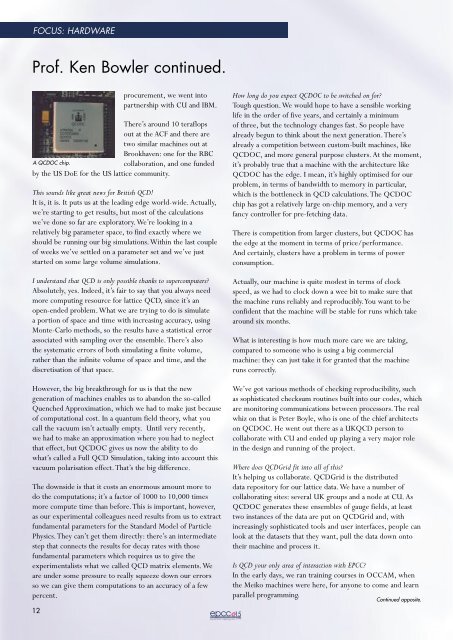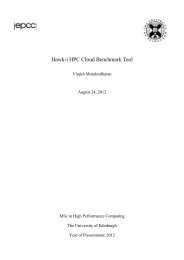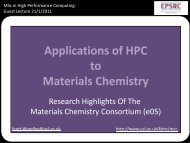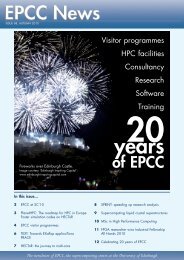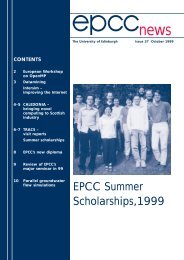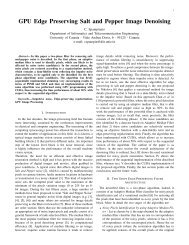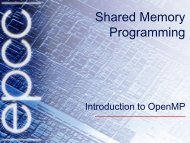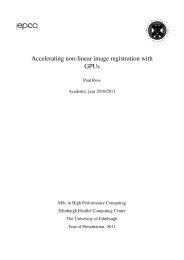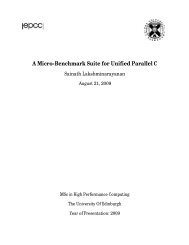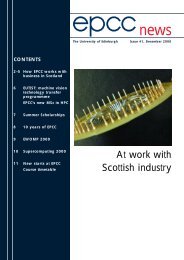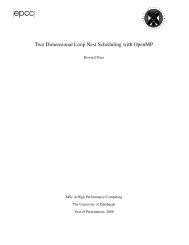Download PDF - EPCC - University of Edinburgh
Download PDF - EPCC - University of Edinburgh
Download PDF - EPCC - University of Edinburgh
Create successful ePaper yourself
Turn your PDF publications into a flip-book with our unique Google optimized e-Paper software.
FOCUS: HARDWAREPr<strong>of</strong>. Ken Bowler continued.procurement, we went intopartnership with CU and IBM.There’s around 10 teraflopsout at the ACF and there aretwo similar machines out atBrookhaven: one for the RBCA QCDOC chip.collaboration, and one fundedby the US DoE for the US lattice community.This sounds like great news for British QCD!It is, it is. It puts us at the leading edge world-wide. Actually,we’re starting to get results, but most <strong>of</strong> the calculationswe’ve done so far are exploratory. We’re looking in arelatively big parameter space, to find exactly where weshould be running our big simulations. Within the last couple<strong>of</strong> weeks we’ve settled on a parameter set and we’ve juststarted on some large volume simulations.I understand that QCD is only possible thanks to supercomputers?Absolutely, yes. Indeed, it’s fair to say that you always needmore computing resource for lattice QCD, since it’s anopen-ended problem. What we are trying to do is simulatea portion <strong>of</strong> space and time with increasing accuracy, usingMonte-Carlo methods, so the results have a statistical errorassociated with sampling over the ensemble. There’s alsothe systematic errors <strong>of</strong> both simulating a finite volume,rather than the infinite volume <strong>of</strong> space and time, and thediscretisation <strong>of</strong> that space.How long do you expect QCDOC to be switched on for?Tough question. We would hope to have a sensible workinglife in the order <strong>of</strong> five years, and certainly a minimum<strong>of</strong> three, but the technology changes fast. So people havealready begun to think about the next generation. There’salready a competition between custom-built machines, likeQCDOC, and more general purpose clusters. At the moment,it’s probably true that a machine with the architecture likeQCDOC has the edge. I mean, it’s highly optimised for ourproblem, in terms <strong>of</strong> bandwidth to memory in particular,which is the bottleneck in QCD calculations. The QCDOCchip has got a relatively large on-chip memory, and a veryfancy controller for pre-fetching data.There is competition from larger clusters, but QCDOC hasthe edge at the moment in terms <strong>of</strong> price/performance.And certainly, clusters have a problem in terms <strong>of</strong> powerconsumption.Actually, our machine is quite modest in terms <strong>of</strong> clockspeed, as we had to clock down a wee bit to make sure thatthe machine runs reliably and reproducibly. You want to beconfident that the machine will be stable for runs which takearound six months.What is interesting is how much more care we are taking,compared to someone who is using a big commercialmachine: they can just take it for granted that the machineruns correctly.However, the big breakthrough for us is that the newgeneration <strong>of</strong> machines enables us to abandon the so-calledQuenched Approximation, which we had to make just because<strong>of</strong> computational cost. In a quantum field theory, what youcall the vacuum isn’t actually empty. Until very recently,we had to make an approximation where you had to neglectthat effect, but QCDOC gives us now the ability to dowhat’s called a Full QCD Simulation, taking into account thisvacuum polarisation effect. That’s the big difference.The downside is that it costs an enormous amount more todo the computations; it’s a factor <strong>of</strong> 1000 to 10,000 timesmore compute time than before. This is important, however,as our experimental colleagues need results from us to extractfundamental parameters for the Standard Model <strong>of</strong> ParticlePhysics. They can’t get them directly: there’s an intermediatestep that connects the results for decay rates with thosefundamental parameters which requires us to give theexperimentalists what we called QCD matrix elements. Weare under some pressure to really squeeze down our errorsso we can give them computations to an accuracy <strong>of</strong> a fewpercent.12We’ve got various methods <strong>of</strong> checking reproducibility, suchas sophisticated checksum routines built into our codes, whichare monitoring communications between processors. The realwhiz on that is Peter Boyle, who is one <strong>of</strong> the chief architectson QCDOC. He went out there as a UKQCD person tocollaborate with CU and ended up playing a very major rolein the design and running <strong>of</strong> the project.Where does QCDGrid fit into all <strong>of</strong> this?It’s helping us collaborate. QCDGrid is the distributeddata repository for our lattice data. We have a number <strong>of</strong>collaborating sites: several UK groups and a node at CU. AsQCDOC generates these ensembles <strong>of</strong> gauge fields, at leasttwo instances <strong>of</strong> the data are put on QCDGrid and, withincreasingly sophisticated tools and user interfaces, people canlook at the datasets that they want, pull the data down ontotheir machine and process it.Is QCD your only area <strong>of</strong> interaction with <strong>EPCC</strong>?In the early days, we ran training courses in OCCAM, whenthe Meiko machines were here, for anyone to come and learnparallel programming.Continued opposite.


